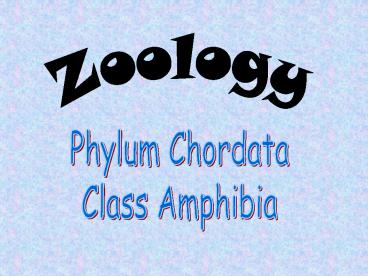Zoology - PowerPoint PPT Presentation
1 / 14
Title:
Zoology
Description:
General Characteristics First vertebrates on land 4000 species Strong skeleton to support body weight Nostrils for breathing through nose 3 chambered heart Air ... – PowerPoint PPT presentation
Number of Views:743
Avg rating:3.0/5.0
Title: Zoology
1
Zoology
Phylum Chordata Class Amphibia
2
General Characteristics
- First vertebrates on land
- 4000 species
- Strong skeleton to support body weight
- Nostrils for breathing through nose
- 3 chambered heart
- Air breathing lungs
- Carnivorous diet
- Eardrum
- Eyelids
3
- Important accommodations needed for land because
of
- Oxygen content
- Density
- Temperature regulation
- Habitat diversity
4
Donovan Period
- 400 million years ago
- Mild temperatures and cycles of drought then
heavy rainfall, then drought
- Unstable environment when many pools evaporated,
only those able to acquire atmospheric oxygen
survived
- Gills would collapse, dry, and lose function
- Lobe-finned fish and lungfish were at an advantage
- A kind of lung (extension of pharynex)
- Bones in fins are like that in arms and legs or
early amphibians
- Came to land to escape predators or get food
5
bony or cartiliginous structures in lobed fin
undergoing modificaiton
limb bones of early amphibians
Fig. 27.11, p. 462
6
3 Orders of Amphibians 1. Urodela
- Tailed ones
- Salamanders, newts, mudpuppies
- 400 species
- Some are entirely aquatic and some live on land
- Most walk by bending side to side
- Usually internal fertilization female picks up
sperm packet, spermatophore, and inserts it into
her cloaca
- Born with gills, but these are usually lost in
all but aquatic forms
- Some do not have lungs or gills and use only skin
and mouth for gas exchange
7
In-text, p. 463
8
2. Anura
- Tail-less ones
- Frogs and toads
- 3500 species
- More specialized for living on land
- Use strong legs to hop
- Flick tongue to catch insects
- Defense from predators
- Camouflage
- Secrete mucus bad tasting or poisonous
- Many with poison have a bright color to warn
predators
9
(No Transcript)
10
3. Apoda
- Leg-less ones
- Caecilians
- Nearly blind
- Look like earthworms
- 160 species
- Burrow through soil
- Live in South America, Africa and Southeast Asia
- Internal fertilization
- Viviparous live birth
11
(No Transcript)
12
Frog
Tadpole
Adults
Aquatic with gills
Gills and tail disappear
Lateral line
Lateral line
Develops legs
Finned tail
- Some frogs do not go through the tadpole phase
- Some are strictly aquatic and some are strictly
land
- Salamanders and caecilians resemble adults when
born
13
- Even land dwelling amphibians need a moist habitat
- Need to stay moist
- Some breath through skin and mouth because they
have no lungs
- Eggs do not have a shell and dehydrate in air
- Male causes female to release eggs and spills
sperm while she does this
- Some incubate eggs on back, mouth or in stomach
- Some are ovoviviparons and viviparons
- Ovoviviparons eggs hatch in uterus
- Viviparons young develop in uterus
14
- Frogs are usually quiet, but may call during
mating season
- Many want to protect territory or attract females































